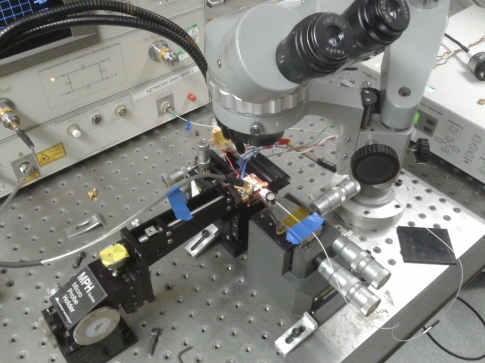CST Global Presents Interim Results Of IBROW Project

Detuned DFB lasers increase modulation efficiency in fibre-optic transmission
CST Global, a UK III-V optoelectronics semiconductor foundry, has presented interim results of the iBROW project (Innovative ultra-Broadband Ubiquitous Wireless Communications Through Tera-hertz Transceivers), led by the University of Glasgow.
iBROW is an EU Horizon 2020 project to develop a novel, energy-efficient and compact ultra-broadband short-range wireless communication transceiver technology, seamlessly interfaced with optical fibre networks and capable of addressing future network needs.
Speaking at the Applications in Optics and Photonics (AOP) conference in Faro, Portugal, May 2017, CST research engineer, Horacio Cantu said: "We can modulate light with radio-data, for transmission over fibre-optic networks, without analogue to digital conversion. The available bandwidth is huge; there is almost no latency; and the data can remain in its original format, for transmission via passive networks."
The work is outlined in a white paper: 'Performance characteristics of 1550 nm and 1310 nm detuned, ridge waveguide, distributed feedback, laser diodes' (AO100-194), co-authored by CST's director of engineering, Andrew McKee.
The white paper is concerned with the performance of in-plane, ridge waveguide, DFB laser diodes for data transmission, centred on 1550 nm and 1310 nm wavelengths.
As Cantu explained: "We successfully showed that "˜detuning' DFB lasers from their peak optical gain increases modulation efficiency; a bias power to frequency characteristic proportional to data carrying capacity or bandwidth. We also showed that, as the temperature increases from 25degC to 85degC, modulation efficiency can also be increased.
"Both carrier wavelengths enable an ultra-broadband solution. We found 1310 nm lasers had greater modulation efficiency than 1550 nm lasers. However, because 1550 nm has a much larger transmission range, more research is required to establish if it is the best, practical, ultra-broadband solution in the long-term.
"We are a long way from a commercial, ultra-broadband solution that is low cost, energy-efficient, compact, operates at room temperature and integrates consumer portable devices and fibre-optic networks. However, the white paper concludes that detuning DFB laser transmitters increases bandwidth capacity in optical fibre networks."
In addition to the University of Glasgow and CST, the iBROW consortium includes Alcatel-Lucent, IQE, Optocap, TU Braunschweig and Universidade do Algarve.


































